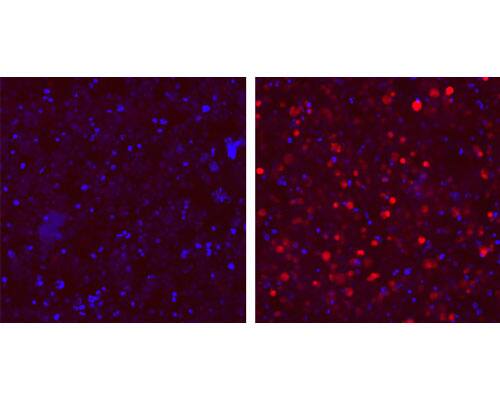FKBP12: Fluorescent Probes and Dyes
FK506 binding protein, also called FKBP12 and FKBP1A, was originally characterized as a peptidyl-prolyl isomerase that catalyzes the transition between cis- and trans-proline residues critical for proper folding of proteins. The macrolide immunosuppressants FK506 (Tacrolimus) and rapamycin bind to FKBP12 with high affinity, while the structurally related-compound cyclosporine binds with a much lower affinity. The binding of these drugs causes FKBP12 to become a potent inhibitor of calcineurin phosphatase activity and TOR kinase activity. Knockout mice lacking FKBP12 are morphologically normal, but develop cardiomyopathies that may be related to dysregulation of ryanodyne receptors.
3 results for "FKBP12 Fluorescent Probes and Dyes" in Products
3 results for "FKBP12 Fluorescent Probes and Dyes" in Products
FKBP12: Fluorescent Probes and Dyes
FK506 binding protein, also called FKBP12 and FKBP1A, was originally characterized as a peptidyl-prolyl isomerase that catalyzes the transition between cis- and trans-proline residues critical for proper folding of proteins. The macrolide immunosuppressants FK506 (Tacrolimus) and rapamycin bind to FKBP12 with high affinity, while the structurally related-compound cyclosporine binds with a much lower affinity. The binding of these drugs causes FKBP12 to become a potent inhibitor of calcineurin phosphatase activity and TOR kinase activity. Knockout mice lacking FKBP12 are morphologically normal, but develop cardiomyopathies that may be related to dysregulation of ryanodyne receptors.
Fluorogenic srTAG probe for live cell imaging of FBKP12 (F36V/L) fusion proteins
| Chemical Name: | 4-((2-(2-(3-((R)-3-(3,4-Dimethoxyphenyl)-1-(((S)-1-((S)-2-(3,4,5-trimethoxyphenyl)butanoyl)piperidine-2-carbonyl)oxy)propyl)phenoxy)acetamido)ethyl)carbamoyl)-2-(3-(3-fluoroazetidin-1-ium-1-ylidene)-7-(3-fluoroazetidin-1-yl)-5,5-dimethyl-3,5-dihydrodibenzo[b,e]silin-10-yl)benzoate |
| Purity: | ≥95% (HPLC) |
Fluorogenic srTAG probe for live cell imaging of FBKP12 (F36V/L) fusion proteins
| Chemical Name: | 2-(3-(3,3-Difluoroazetidin-1-ium-1-ylidene)-6-(3,3-difluoroazetidin-1-yl)-3H-xanthen-9-yl)-4-((2-(2-(3-((R)-3-(3,4-dimethoxyphenyl)-1-(((S)-1-((S)-2-(3,4,5-trimethoxyphenyl)butanoyl)piperidine-2-carbonyl)oxy)propyl)phenoxy)acetamido)ethyl)carbamoyl)benzoate |
| Purity: | ≥95% (HPLC) |
Fluorogenic srTAG probe for live cell imaging of FKBP12(F36V/L) fusion proteins
| Chemical Name: | 2-(3-(3,3-Difluoroazetidin-1-ium-1-ylidene)-6-(3,3-difluoroazetidin-1-yl)-10,10-dimethyl-3,10-dihydroanthracen-9-yl)-4-((2-(2-(3-((R)-3-(3,4-dimethoxyphenyl)-1-(((S)-1-((S)-2-(3,4,5-trimethoxyphenyl)butanoyl)piperidine-2-carbonyl)oxy)propyl)phenoxy)acetamido)ethyl)carbamoyl)benzoate |
| Purity: | ≥95% (HPLC) |



